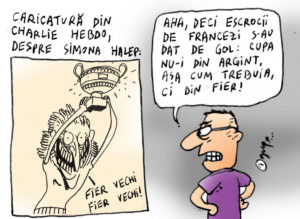A Romanian woman wins Roland Garros. “Scrap iron! Scrap iron!” Source, Facebook, June 14, 2018
What do we see here?
On June 9, 2018, Simona Halep became the second Romanian tennis player to win a Grand Slam title, at Roland Garros, after Virginia Ruzici, who was successful in 1978, at the same tennis tournament. On June 14, 2018, Dan Alexe, a Romanian journalist and writer, translated the editorial from the French satirical magazine Charlie Hebdo and distributed the cartoon below.
Although the text in the cartoon does not include the name of the winner, it can be easily decoded in the context of the events. The cartoon depicts a woman tennis player holding a trophy, while happily shouting: “Scrap iron! Scrap iron!”
Which public issue is being addressed here?
Two main ethnic stereotypes are under scrutiny here. On the one hand, Roma(ni)/ gypsies (considered pejorative) are associated with stealing, usually metals on construction sites and copper from the railway to be sold for money, because of poverty. On the other, a high percentage of French hold unfavourable views of Roma(ni) / gypsies and associate Romanians with Roma(ni)/ gypsies. Therefore, Romanians are associated with stealing.
What does the humour do?
The cartoon may be interpreted in the key of ethnic humour, heavily relying on stereotypes. In this particular case, a predominantly national stereotype – based on the transfer of an attribute from one category (an occupational category, thieves) onto another (the Roma ethnic group) – is adopted by a different nation, the French.
This cartoon becomes the first part of a dialogic action game, which received various reactions in the Romanian online press. For example, the caricature below, by Lucian Amarii (JUP), was one of the answers to the original one.
 (left) Caricature from Charlie Hebdo about Simona Halep. (Text on billboard: “Scrap iron! Scrap iron!”, translated into Romanian)
(left) Caricature from Charlie Hebdo about Simona Halep. (Text on billboard: “Scrap iron! Scrap iron!”, translated into Romanian)
(right) Aha, so the French crooks gave themselves away: the cup is not made of silver, as it should be, but of iron.
Source: in IQAds, June 15, 2018
What do we see here?
The person on the right is standing with his arms akimbo, frowning at the translated version of the cartoon from Charlie Hebdo. This time, the name of the woman tennis player is explicit and the text is given in Romanian, not in French. In his comment, the man starts from the premise that the tennis player is telling the truth about the cup and foregrounds the stereotype “French are deceptive/ liars”.
What does the humour do?
This cartoon may be interpreted in the key of ethnic humour: Romanians tend to appreciate the Western world and trust their compatriots, especially if they are public persons. Once they find out that something went wrong, Romanians will change their opinion and transfer a negative attribute to an entire nation.
I contend the two cartoons are a dialogue since they both build on the same type of humour and their target may be the population at large. Both cartoons may be satires in multiple layers: on the one hand, the original caricature aims at making the French aware of diversity and acceptance, on the other, the Romanian cartoon aims at making Romanians aware of their (sometimes) changing attitude towards others.
Bibliography
Popescu, Carmen. 2011. “Understanding ethnic humour in Romanian jokes”. In The Pragmatics of Humour across Discourse Domains, ed. by Marta Dynel, 173-190. Amsterdam: John Benjamins. https://doi.org/10.1075/pbns.210.12pop
Prosan, Timea and Noémi Tudor. 2020. “Ethnic identity in jokes with Hungarians and Romanians”. In Romanian Humour. Humour and Culture 5, ed. by Mihaela-Viorica Constantinescu, Stanca Măda and Răzvan Săftoiu, 303-318. Krakow: Tertium. https://www.tertium.edu.pl/publikacje/seria-humour-and-culture-/humour-and-culture-5.html
Săftoiu, Răzvan. 2017. “The ethnic category from a linguistic perspective”, Diacronia, https://www.diacronia.ro/ro/journal/issue/5/A73/en/pdf
Scripnic, Gabriela and Diana E. Popa. 2015. “From hostile humour to stereotyping in televised satire Les Guignols de l’Info”, Language and Dialogue 5(1): 90-106. https://doi.org/10.1075/ld.5.1.05scr
